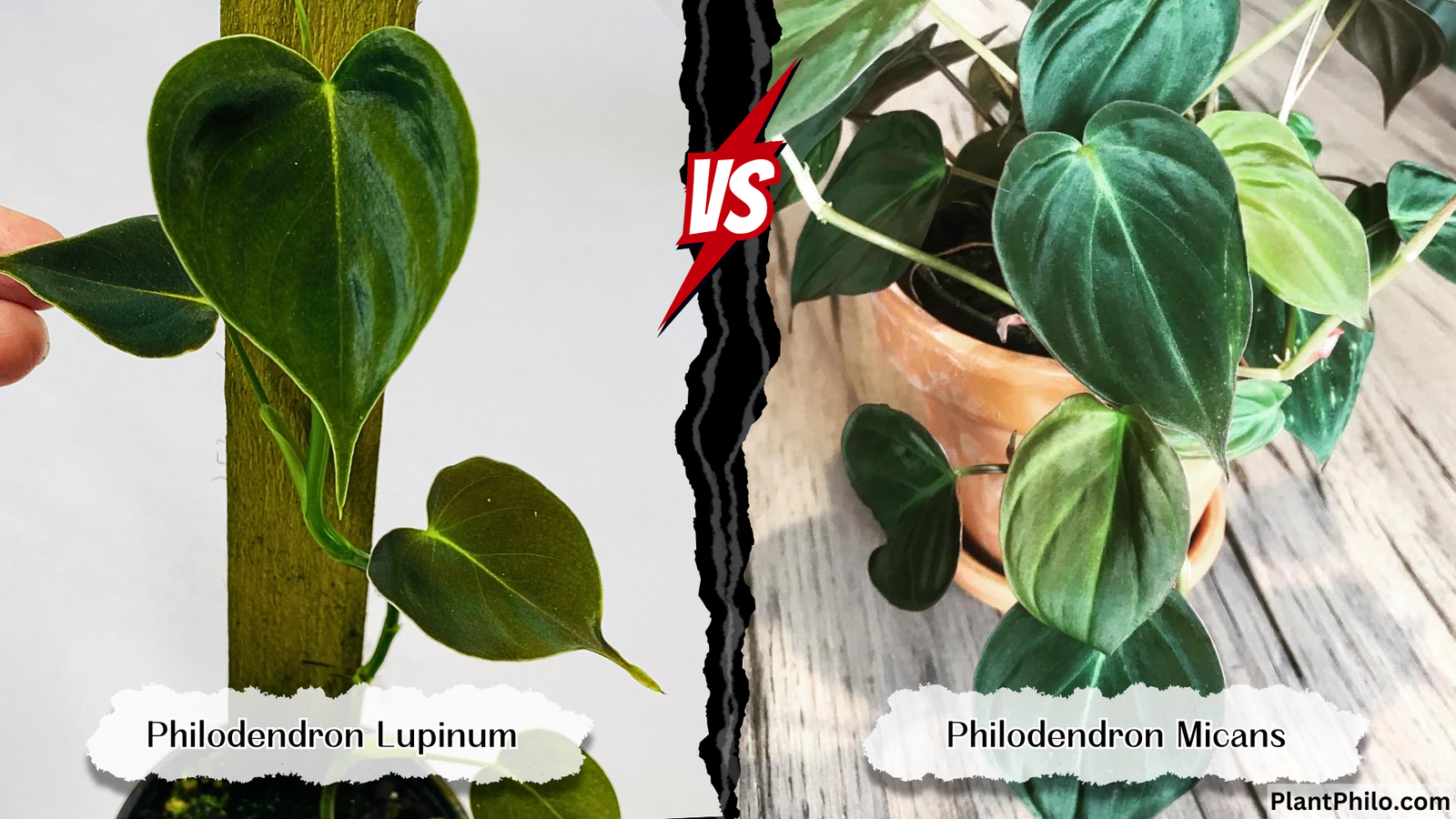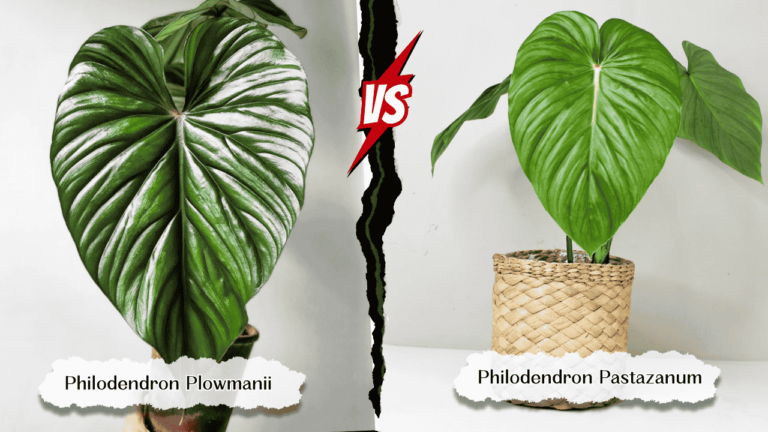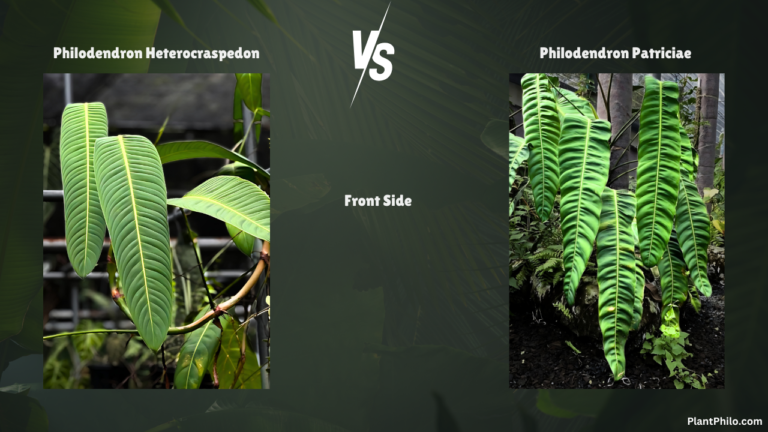Lupinum Vs Micans? Know the Distinction Once & for All!
Philodendron Lupinum or Micans? It’s like choosing between two shimmering jewels in a treasure chest – both captivating but with subtle nuances that set them apart.
If you’re feeling a bit lost in the lush world of Philodendrons, fret not! We’re about to embark on a botanical expedition, unearthing the secrets of these two delicate beauties. Let’s ensure you pick the perfect vining treasure to adorn your indoor jungle.
Comparison Table: Philodendron Lupinum vs. Micans
| Feature | Philodendron Lupinum | Philodendron Micans |
| Botanical Name | Philodendron lupinum | Philodendron hederaceum var. hederaceum |
| Common Names | Wolf’s Ear Philodendron, Red-Backed Philodendron | Velvet-Leaf Philodendron, Heartleaf Philodendron |
| Origin | Ecuador | Central America & the Caribbean |
| Growth Habit | Vining, climbing with support | Vining, climbing or trailing |
| Leaf Shape & Size | Elongated, lance-shaped to ovate, 4-8 inches long | Heart-shaped, 2-4 inches long |
| Color | Velvety, deep green with reddish undersides, new leaves often bronze-red | Iridescent, velvety leaves shifting from bronze to deep green with hints of purple or red depending on light |
| Light Requirements | Bright, indirect light for optimal color; tolerates low light but colors may fade | Bright, indirect light for optimal iridescence; tolerates low light but colors may fade |
| Watering Needs | Water when top 2-3 inches of soil are dry | Water when top inch of soil is dry |
| Humidity | Appreciates higher humidity but tolerates average levels with extra care | Thrives in higher humidity (60-80%), tolerates average levels with extra care |
| Fertilizing | Balanced liquid fertilizer diluted to half-strength, monthly during growing season | Balanced liquid fertilizer diluted to half-strength, monthly during growing season |
| Common Pests & Diseases | Mealybugs, scale, spider mites | Mealybugs, scale, spider mites |
| Propagation | Stem cuttings in water or soil | Stem cuttings in water or soil |
| Toxicity | Toxic to pets and humans if ingested | Toxic to pets and humans if ingested |
| Petiole | Slender, often reddish | Slender, often reddish |
| Stem | Thin, vining, develops aerial roots | Thin, vining, develops aerial roots |
| New Leaf Color | Bronze-red, maturing to deep green | Bronze or copper, maturing to iridescent green |
| Air Purifying | Moderate air purifying qualities | Moderate air purifying qualities |
| Overall Difficulty | Moderately easy to care for | Easy to care for |
| Mature Size | Can reach 6-10 feet with support | Can reach 6-10 feet with support |
In-Depth Comparison
Leaf Shape & Size
Both the Lupinum and Micans showcase elongated, heart-shaped leaves, adding a touch of elegance to your plant collection.
However, the Lupinum’s leaves tend to be slightly larger and more lance-shaped, while the Micans’ leaves are smaller and more rounded, resembling a classic heart. It’s like comparing a graceful ballerina to a playful sprite – both beautiful but with distinct charm
Color
The Lupinum boasts velvety, deep green leaves with a captivating reddish underside. New leaves often emerge in a striking bronze-red, gradually maturing to a deep green. The Micans, on the other hand, is renowned for its iridescent foliage.
Its leaves shimmer and change color depending on the light, shifting from bronze to deep green with hints of purple or red. It’s like having a living chameleon in your home, constantly surprising you with its ever-changing beauty.
Growth Habit: Vining Wonders
Both plants are enthusiastic climbers eager to reach new heights with the help of a moss pole or trellis. Picture them as intrepid explorers, venturing upwards and outwards, creating a lush tapestry of foliage. If you prefer a cascading look, you can also let them trail gracefully from a hanging basket.
Light & Water: Striking a Balance
Both the Lupinum and Micans thrive in bright, indirect light. This helps them maintain their vibrant colors and encourages healthy growth. While they can tolerate lower light conditions, their colors might fade, and their growth might slow down.
Avoid direct sunlight, as it can scorch their delicate leaves. When it comes to watering, both plants prefer their soil to dry out slightly between waterings. Allow the top 2-3 inches of soil to dry out for the Lupinum and the top inch for the Micans before reaching for your watering can.
Humidity: Tropical Delights
Hailing from tropical regions, both plants appreciate a humid environment. Think of it as their way of staying connected to their roots.
While they can tolerate average household humidity, they’ll flourish in higher humidity levels (60-80%). You can increase humidity by misting them regularly, using a pebble tray, or running a humidifier.
Fertilizing, Pests & Propagation: Shared Traits
Both plants benefit from a monthly dose of diluted liquid fertilizer during their growing season. They’re also susceptible to the same common houseplant pests, such as mealybugs, scale, and spider mites.
Vigilance and prompt treatment are key to keeping these pests at bay. Both the Lupinum and Micans can be easily propagated from stem cuttings. Simply take a cutting with at least one node and place it in water or moist soil.
Toxicity: A Gentle Reminder
While these plants are a feast for the eyes, they’re not meant for consumption. Both contain calcium oxalate crystals, which can cause irritation and swelling if ingested. Keep them out of reach of pets and curious children.
Overall Difficulty & Mature Size: Growing with Ease
Both plants are considered moderately easy to care for, making them suitable for plant enthusiasts of various skill levels.
The Micans, with its slightly higher tolerance for average humidity, might have a slight edge for beginners. Both plants can reach a mature size of 6-10 feet with support, so ensure you have enough space for them to climb and flourish.
FAQs: Addressing Your Queries
Which plant is better for low-light conditions?
Both plants tolerate low light, but their colors might be less vibrant. The Micans might have a slight edge due to its naturally darker foliage.
Which plant is faster-growing?
Both plants have a moderate growth rate, but the Micans might exhibit slightly faster growth under ideal conditions.
Can I train these plants to climb?
Absolutely! Provide them with a moss pole or trellis and gently guide their vines upwards.
Why are the new leaves on my Lupinum green instead of bronze-red?
New leaves often emerge in a lighter color and develop their mature coloration as they grow.
How can I enhance the iridescence of my Micans?
Provide bright, indirect light and ensure adequate humidity.
Can I propagate these plants in water?
Yes, both plants can be propagated in water, but rooting in soil is generally faster and more successful.
What should I do if I see pests on my plant?
Isolate the infested plant and treat it with insecticidal soap or neem oil.
Why are the leaves on my plant turning yellow?
Yellowing leaves can indicate overwatering, underwatering, or nutrient deficiencies.
Can I grow these plants outdoors?
Yes, in warm climates, but it provides protection from harsh direct sunlight.
Which plant is rarer and more expensive?
The Philodendron Lupinum is generally considered rarer and can be more expensive than the Micans.
Concluding,
Choosing between the Philodendron Lupinum and Micans is a delightful dilemma. If you’re drawn to velvety textures and deep, rich colors, the Lupinum might be your perfect match. If you crave an iridescent spectacle that changes with the light, the Micans will steal your heart.
Remember, both plants bring a touch of tropical elegance and charm to any space. With proper care and attention, they’ll reward you with their stunning foliage for years to come.




